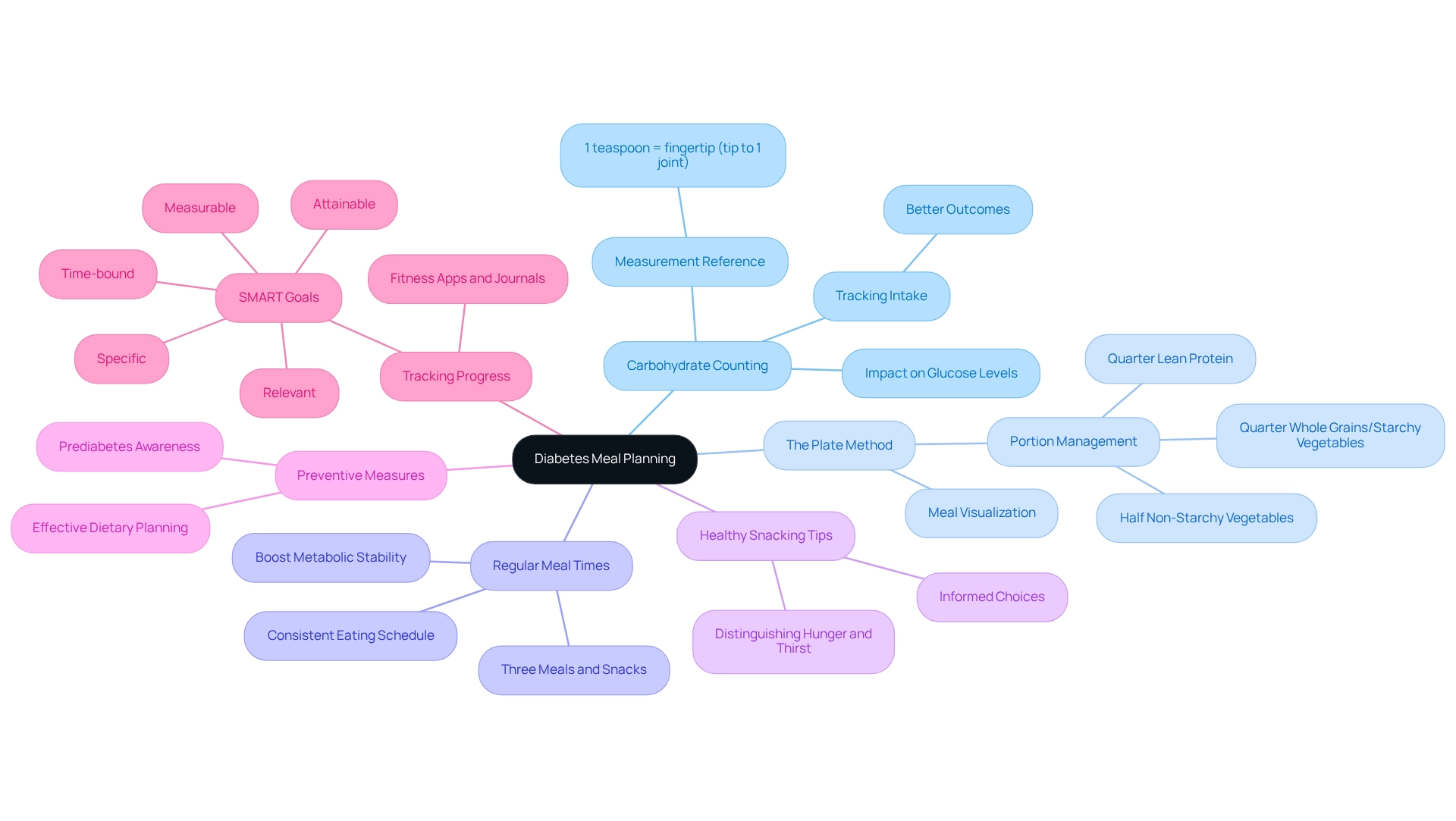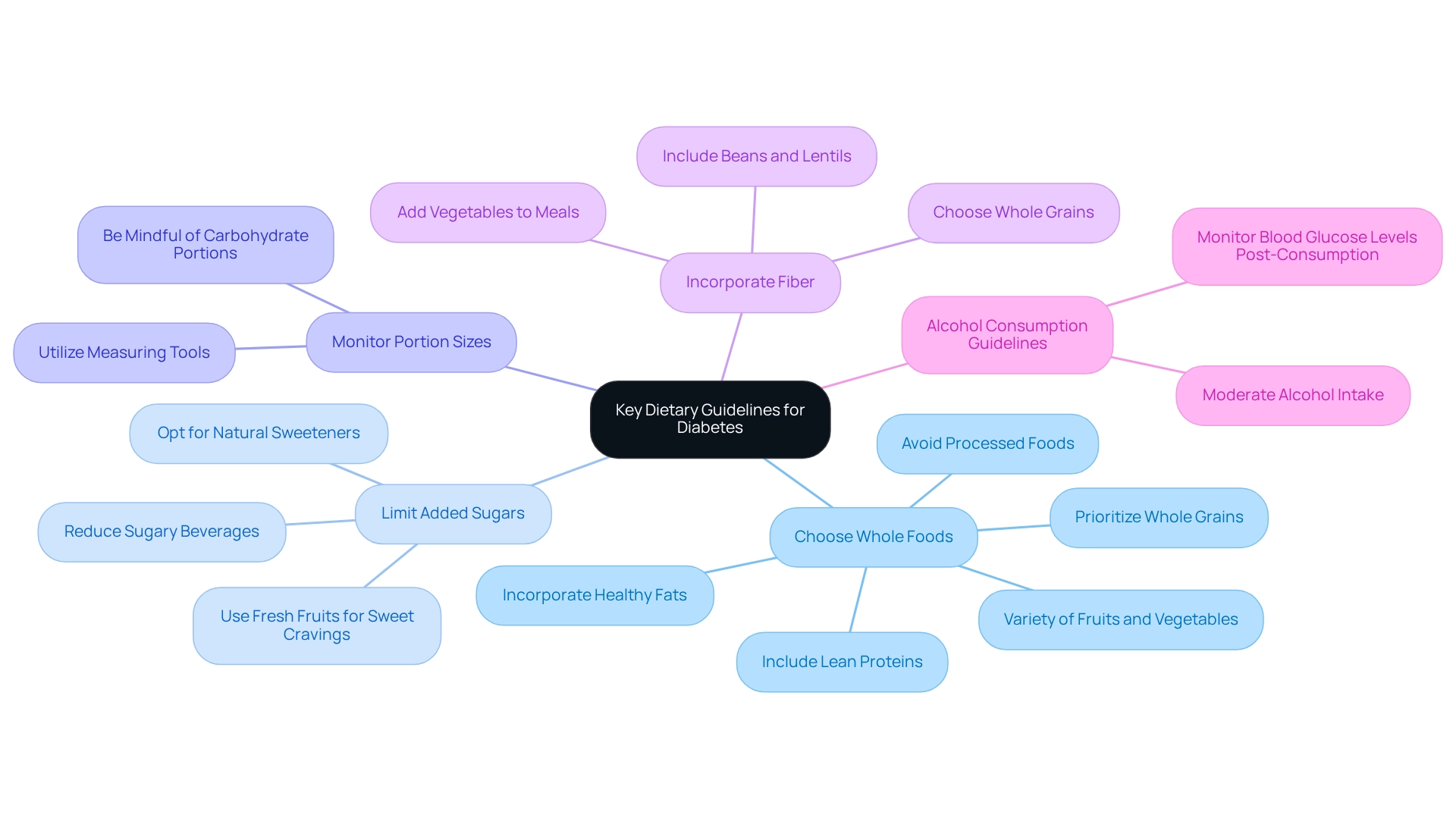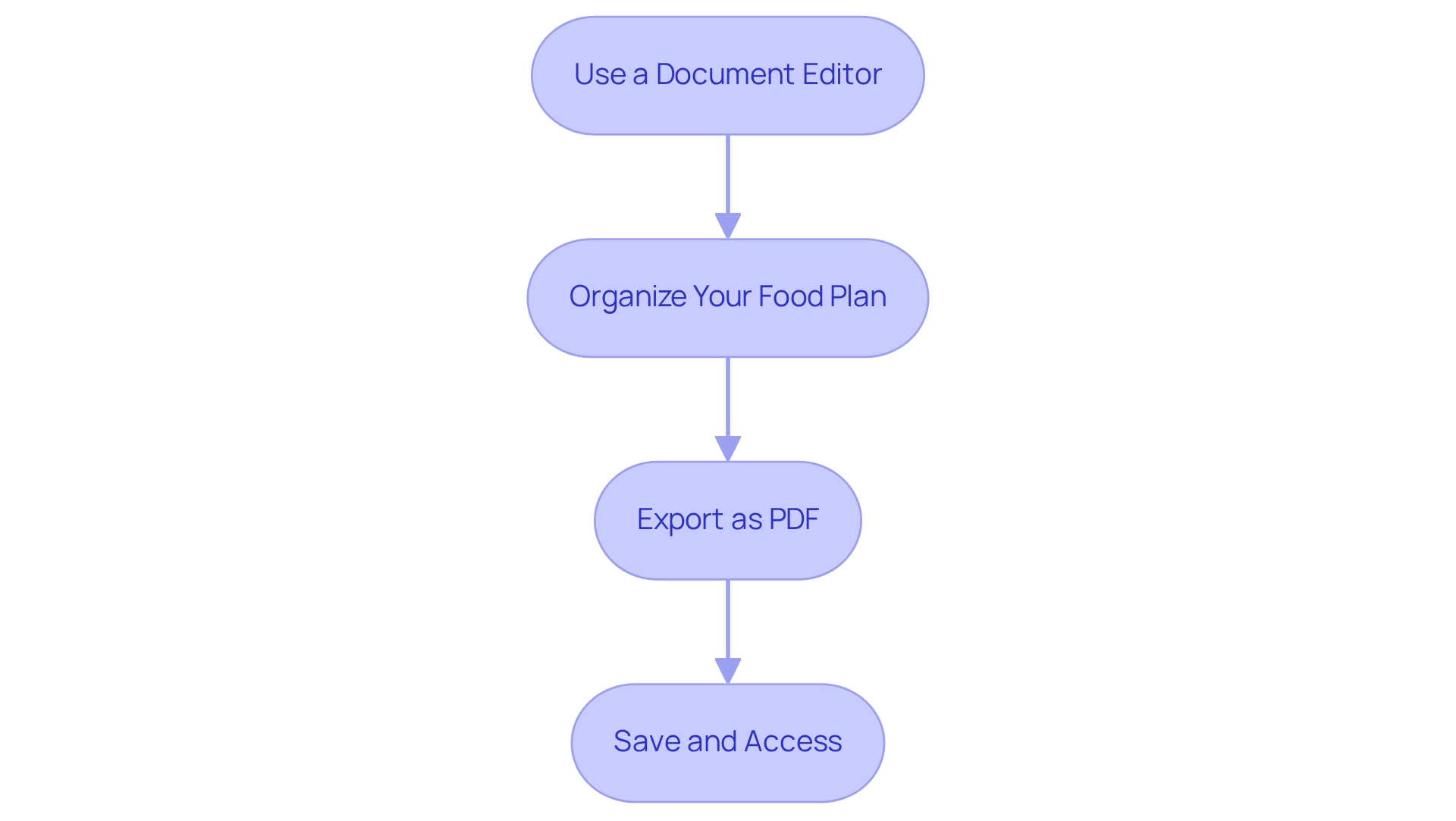Overview
Creating a diabetes meal plan PDF can feel overwhelming, but it’s a crucial step toward managing your health effectively. It’s important to recognize that assessing your dietary needs and planning balanced meals can make a significant difference. Many patients find that utilizing effective strategies, such as carbohydrate counting and the plate method, simplifies this process.
As you embark on this journey, remember the value of whole foods, portion control, and regular meal times. These elements are not just guidelines; they are essential tools to help you manage your blood sugar levels. Think about how incorporating these practices can lead to a healthier lifestyle, one step at a time.
Consider the support available to you. The 30-Day Diabetes Reset program offers a nurturing environment where you can learn and grow. You’re not alone in this; many have walked this path and found success. With patience and the right strategies, you can take control of your health and feel empowered in your choices.
Introduction
Managing diabetes can feel overwhelming at times, but meal planning is a crucial element that can significantly influence your health outcomes. It’s important to recognize that with the right strategies, you can take control of your blood sugar levels while still enjoying a diverse and satisfying diet. This article explores the essentials of diabetes meal planning, highlighting effective methods such as:
- Carbohydrate counting
- The plate method
- The importance of regular meal times
Many patients find that by understanding key dietary guidelines and developing personalized meal plans, they can navigate their nutritional needs more effectively. This not only enhances their overall quality of life but also empowers them to embrace a healthier lifestyle. Incorporating technology to track progress can further support you on this journey, making diabetes management a more achievable and engaging endeavor. Together, let’s explore how you can take charge of your health and enjoy the journey ahead.
Understand the Basics of Diabetes Meal Planning
Diabetes dietary planning, which can be found in a diabetes meal plan PDF, is an organized method of eating that effectively regulates glucose levels, and it can feel overwhelming at times. But don’t worry; you’re not alone in this journey. Let’s explore some key concepts that can help you manage your health with confidence.
- Carbohydrate Counting: Understanding how carbohydrates impact your glucose is essential. Aim to consume a consistent amount of carbohydrates at every meal. This practice helps stabilize blood sugar levels and can significantly improve glycemic control, making it a vital strategy for diabetes management. A practical reference for measuring carbohydrates is that 1 teaspoon is estimated by the fingertip (tip to 1 joint), according to the National Center for Chronic Disease Prevention and Health Promotion. Many patients find that keeping track of their carbohydrate intake leads to better outcomes.
- The Plate Method: Visualize your meals by dividing your plate into sections: half for non-starchy vegetables, a quarter for lean protein, and a quarter for whole grains or starchy vegetables. This technique streamlines portion management while ensuring a balanced intake of nutrients, which is crucial for your overall health. It’s a simple yet effective way to make sure you’re getting what you need.
- Regular Meal Times: Eating at consistent times can help regulate glucose levels. Strive for three meals and one or two snacks each day to maintain energy and avoid spikes in glucose. Creating a routine can boost your metabolic stability and enhance dietary compliance. Have you noticed how much easier it is to stick to your diabetes meal plan PDF when you have a schedule? Integrating these fundamental components into your diabetes meal plan PDF can empower you to take charge of your health. For instance, the center’s guidance on healthy snacking emphasizes the importance of distinguishing between hunger and thirst. This insight can help you make informed choices that contribute to overall dietary control. It’s essential to recognize that a diagnosis of prediabetes does not guarantee advancement to type 2 diabetes; preventive measures can be implemented through effective dietary planning. By mastering these basics, you can develop a diabetes meal plan PDF that supports your health goals and enhances your quality of life. Furthermore, utilizing tracking methods such as fitness apps and journals can help you monitor your progress and set SMART goals—specific, measurable, attainable, relevant, and time-bound. For instance, you might strive to include more local produce from San Marcos’ farmers’ markets in your meals, which can improve both your nutrition and community involvement. By prioritizing these strategies, you can cultivate a sense of achievement and maintain engagement in your diabetes management journey. Remember, every small step you take is a victory worth celebrating.
Identify Key Dietary Guidelines for Diabetes
Creating a diabetes meal plan PDF can feel overwhelming, but it’s important to recognize that small, intentional changes can lead to significant improvements in your health. Here are some dietary guidelines to consider:
- Choose Whole Foods: Prioritize whole grains, lean proteins, healthy fats, and a variety of fruits and vegetables. Dr. Jason Shumard emphasizes the importance of avoiding processed foods laden with sweeteners and unhealthy fats, as these can exacerbate glucose-related issues. The Integrative Wellness Center’s 30-Day Diabetes Reset program includes a diabetes meal plan pdf that offers structured guidance on how to incorporate these wholesome foods into your diet.
- Limit Added Sugars: Many people find it challenging to reduce sugary beverages and snacks. Instead, consider opting for natural sweeteners or fresh fruit to satisfy your sweet cravings. This aligns beautifully with the holistic approach to nutrition championed by the Integrative Wellness Center.
- Monitor Portion Sizes: It’s essential to be mindful of portion sizes, especially for carbohydrate-rich foods that can impact glucose levels. Utilizing measuring cups or a food scale can help ensure you’re serving appropriate amounts, a vital practice for effective management of diabetes.
- Incorporate Fiber: Foods rich in dietary fiber, such as beans, lentils, whole grains, and vegetables, play a crucial role in regulating blood sugar levels. A high-fiber diet has been shown to improve overall health outcomes for individuals with type 2 diabetes, which is a key focus of Dr. Shumard’s functional medicine strategies.
Recent studies reveal that about 60% of individuals with diabetes-related conditions struggle to include enough whole foods in their diets. This highlights the ongoing need for education and support. Additionally, moderate alcohol intake has been suggested for those with type 2 diabetes, along with tracking blood glucose levels after consumption to avoid reactive hypoglycemia. By following these guidelines, you can craft a balanced dietary plan, which can be detailed in a diabetes meal plan pdf, that promotes your health and effectively manages blood sugar levels.
As Dr. Jason Shumard wisely states, “By providing patients with actionable insights and practical tools, the center fosters an environment where individuals can reclaim their health and well-being.” For personalized guidance and support tailored to your unique needs, consider reaching out to Dr. Shumard and participating in community wellness programs that can enhance your health management journey.
Develop Your Personalized Diabetes Meal Plan
Creating a personalized diabetes meal plan pdf can feel overwhelming, but you can take it step by step. Let’s explore how you can create a diabetes meal plan pdf that works for you.
-
Assess Your Needs: Start by evaluating your daily caloric requirements, which typically range from 1,600 to 2,200 calories for individuals with type 2 diabetes. This can vary based on factors like age, gender, and activity level. It’s also essential to consider any dietary restrictions or preferences that may influence your choices when following the diabetes meal plan pdf.
-
Plan Your Dishes: Organizing your meals can make a significant difference. Many find the plate method helpful. For example:
- Breakfast: Enjoy oatmeal topped with fresh berries and a sprinkle of nuts for those healthy fats.
- Lunch: A vibrant grilled chicken salad filled with colorful vegetables ensures a variety of nutrients.
- Dinner: Consider baked salmon served with quinoa and steamed broccoli for a balanced mix of protein and fiber.
-
Healthy snacks should be included in your diabetes meal plan pdf to help maintain stable energy levels. Options like Greek yogurt, a handful of nuts, or sliced vegetables with hummus can assist you in controlling hunger between meals.
-
Stay Flexible: It’s important to adjust your food plan based on your daily routine and how you feel. Listening to your body is crucial; you might need to make changes to align with your energy levels and preferences.
-
Incorporate Physical Activity: Engaging in a structured walking program can be beneficial. Many patients find success by evaluating their current fitness level and setting realistic goals, such as a daily walk of 10-15 minutes. Joining a local hiking group or participating in community wellness programs in San Marcos can offer additional support and motivation.
-
Track Your Progress: Utilize journals or apps to monitor your food intake and physical activity. This practice can help maintain motivation and allow you to celebrate your achievements along the way.
Research shows that organized walking initiatives can lead to substantial health improvements, boasting a success rate of 89.5% among experts. Remember, diabetes is just one aspect of your life; it doesn’t define you. As Austin Freeman said, “I just took the chance. [Diabetes] wasn’t going to stop me from playing.” Embrace your journey toward better health with confidence and support.
Convert Your Meal Plan into a PDF for Easy Access
To convert your meal plan into a PDF, follow these straightforward steps:
- Use a Document Editor: Open a word processing program such as Microsoft Word or Google Docs.
- Organize Your Food Plan: Clearly outline your dishes and snacks for the week. Utilize headings and bullet points to enhance clarity and organization. It’s important to remember that striving to meet daily fiber guidelines for adults can be effectively managed with a diabetes meal plan pdf or through diet and supplementation. Many patients find that incorporating local produce, such as avocados and berries, enriches their diet and supports blood sugar regulation.
- Export as PDF: In Microsoft Word, navigate to ‘File’, select ‘Save As’, and choose PDF as the file format. For Google Docs, go to ‘File’, click on ‘Download’, and select ‘PDF Document’.
- Save and Access: Store the PDF on your device or in cloud storage for easy access. You can also print it out to keep a physical copy readily available.
By following these steps, you ensure that your customized dietary plan is always accessible, aiding compliance with your health management objectives. Engaging with community wellness programs in San Marcos can provide additional support and resources tailored to your needs. Statistics indicate that utilizing a diabetes meal plan pdf as a digital dietary planning tool can significantly improve dietary adherence among diabetes patients, making this process even more beneficial. Furthermore, professional guidance suggests that a well-organized diabetes meal plan pdf can lead to improved health outcomes. For instance, Norma successfully managed her cholesterol levels by incorporating plant stanols and sterols into her diet, illustrating the positive impact of dietary interventions. Additionally, consulting with a registered dietitian can enhance your meal planning efforts, as they can help develop a personalized plan tailored to your needs. As Dr. Jason Shumard states, “By providing patients with actionable insights and practical tools, the center fosters an environment where individuals can reclaim their health and well-being.
Conclusion
Meal planning is a vital part of managing diabetes effectively. It empowers you to take control of your health while enjoying a diverse and satisfying diet. It’s important to recognize that strategies like carbohydrate counting, the plate method, and regular meal times provide a structured way to eat that can significantly stabilize blood sugar levels. By emphasizing whole foods, limiting added sugars, and monitoring portion sizes, you can enhance your dietary adherence, leading to improved health outcomes.
Creating a personalized meal plan tailored to your unique needs is crucial for success. Many patients find that by:
- Assessing daily caloric requirements
- Planning balanced meals
- Incorporating healthy snacks
- Staying flexible
They can navigate their nutritional needs more effectively. The integration of physical activity and tracking your progress through journals or apps adds another layer of support, fostering a sense of achievement in your diabetes management journey.
Ultimately, embracing these meal planning strategies not only promotes better health but also enriches your quality of life. By prioritizing informed dietary choices and utilizing available resources, you can confidently embark on your path to wellness. Remember, diabetes does not define your life; instead, it can become a manageable part of your overall health journey.
Frequently Asked Questions
What is diabetes dietary planning?
Diabetes dietary planning is an organized method of eating that helps regulate glucose levels, aiming to support individuals in managing their health effectively.
How does carbohydrate counting help in diabetes management?
Carbohydrate counting is essential for understanding how carbohydrates impact glucose levels. Consuming a consistent amount of carbohydrates at each meal helps stabilize blood sugar levels and improve glycemic control.
What is the Plate Method for meal planning?
The Plate Method involves dividing your plate into sections: half for non-starchy vegetables, a quarter for lean protein, and a quarter for whole grains or starchy vegetables. This technique helps manage portion sizes and ensures a balanced nutrient intake.
Why are regular meal times important for diabetes management?
Eating at consistent times helps regulate glucose levels. Striving for three meals and one or two snacks daily can maintain energy and prevent spikes in glucose, enhancing dietary compliance.
How can I distinguish between hunger and thirst when snacking?
Recognizing the difference between hunger and thirst is crucial for making informed dietary choices. This insight can help you manage your overall dietary control more effectively.
Does a diagnosis of prediabetes guarantee progression to type 2 diabetes?
No, a diagnosis of prediabetes does not guarantee advancement to type 2 diabetes. Preventive measures can be implemented through effective dietary planning.
What tools can assist in tracking dietary progress?
Utilizing tracking methods such as fitness apps and journals can help monitor progress and set SMART goals—specific, measurable, attainable, relevant, and time-bound.
How can local produce benefit my diabetes meal plan?
Incorporating more local produce from farmers’ markets can enhance your nutrition and foster community involvement, contributing positively to your diabetes management journey.


